CAP1145 Helicopter Water Impact Survivability Statistics – A Critique
Eurocopter AS332L2 G-WNSB impacted the sea 1.5 nm west of Sumburgh Airport, Shetland Islands on 23 August 2013 (see the last AAIB Special Bulletin) with the loss of 4 lives.
https://youtu.be/C_3xlunGUk0
Within weeks the UK Civil Aviation Authority (CAA) ordered a hurried safety review. This resulted in the CAP1145 report (‘Safety review of offshore public transport helicopter operations in support of the exploitation of oil and gas’), issued in 20 February 2014.  CAP1145 states that between 1976 and 2012 there were 12 fatal accidents involving offshore oil and gas helicopters. These involved 115 fatalities (although 45 were in a single accident, Boeing BV234LR G-BWFC in 1986 [AAIB Report] due to a gear box failure and two related to helideck officer fatalities). Therefore in the 40 years from 1976 to 2015 there were 13 fatal accidents and 119 fatalities. Note: The first UK offshore oil and gas helicopter flight was in February 1965, using a Bristow Westland Whirlwind to the Mr Cap jack-up rig off Sunderland. In CAP 1145, and one year later in the first paragraph of Chapter 1 of CAP 1243, the Offshore Helicopter Review Progress Report, the CAA specifically emphasised that:
CAP1145 states that between 1976 and 2012 there were 12 fatal accidents involving offshore oil and gas helicopters. These involved 115 fatalities (although 45 were in a single accident, Boeing BV234LR G-BWFC in 1986 [AAIB Report] due to a gear box failure and two related to helideck officer fatalities). Therefore in the 40 years from 1976 to 2015 there were 13 fatal accidents and 119 fatalities. Note: The first UK offshore oil and gas helicopter flight was in February 1965, using a Bristow Westland Whirlwind to the Mr Cap jack-up rig off Sunderland. In CAP 1145, and one year later in the first paragraph of Chapter 1 of CAP 1243, the Offshore Helicopter Review Progress Report, the CAA specifically emphasised that:
Evidence showed that just over half of the accidents in which offshore helicopters impacted the sea between 1976 and 2012 were potentially survivable, but led to 38 fatalities.
This relates to crashes into the sea surface, rather than deliberate and controlled ditchings. They also say that 31 of the 38 failed to escape the crashed helicopter. They then go on to justify a Safety Directive on enhanced Emergency Breathing Systems (EBS) and more restrictive seating arrangements depending on passenger and push-out window size. However, readers who closely studied the list of offshore oil and gas helicopters accidents between 1976 and 2012 in CAP1145 Appendix 1 to Annex C ‘Review of Accidents’ would have been unable to identify these 38 fatalities.
Checking the Facts Behind the UK CAA Statement
We asked the CAA to identify which accidents they included. They identified 9 accidents with 39 (not 38) fatalities in that time period. One third of those accidents and 20 of the 39 fatalities do not relate to offshore oil and gas flights and so aren’t detailed in the CAP1145 Annex C ‘Review of Accidents’. Mixing datasets can lead to the suspicion of searching for data to support your chosen course of action. The CAA say that these non-oil and gas accidents have lessons that are relevant to oil and gas survivability, though of course so would non-UK accidents. However, an accident 20, 30 or 40 years ago will feature non-crashworthy seating and potentially primitive safety equipment that may render any supposed lessons void. Below we look to see how relevant these accidents are for improvements to water egress, just one element of surviving an offshore accident, but the element that received most attention in CAP1145. We have marked then RELEVANT or IRRELEVANT in relation to the benefit of having an EBS that can be deployed underwater ( a ‘Cat A’ EBS, something we discussed in an earlier article) and of having a window exits compatible with the size of the passengers who would have to use it. We have also considered, based on information in the AAIB reports, if the occupants who died inside the aircraft were in a fit state after the impact to egress with such enhancements. This is clearly subjective, but vital to understand when considering were to direct safety improvement effort.
UK Oil and Gas Survivable Water Impact Accident Analysis
- Sikorsky S-58T G-BCRU 21 April 1976: 10 Persons on Board (POB) / 1 fatality (AAIB Report): This aircraft did not fall into the sea but onto the deck of the crane barge Thor after a tail rotor failure. (IRRELEVANT: not a water impact! We suspect this accident was not included in the original CAP1145 water impact statistics, explaining the 38 to 39 fatality discrepancy).
- Bell 212 G-BIJF 12 August 1981: 14 POB / 1 fatality (AAIB report): Water impact after loss of control East of Shetland. Remarkably the passengers were not required to wear survival suits during inter-rig transfers by the oil company customer. They only wore life jackets stowed in pouches around their waist that needed to be donned before inflation. The last passenger to surface had been unable to open his seat belt buckle, was observed to be in a weak state and his lifejacket repeated slipped over his head. Other survivors held on to him until they became exhausted and lost their grip. He drifted off and was later found drowned. (IRRELEVANT: all POB did egress the aircraft and the fatality would have been far less likely with a modern survival suit and lifejacket).
- Bolkow Bo105 G-AZOM 24 July 1984 : 3 POB / 0 fatalities (AAIB report): Water impact after loss of control while attempting a ditching due to tail rotor failure while flying along the coast between two onshore heliports. (IRRELEVANT: all POB egressed and survived)
- Sikorsky S-61N G-BEWL (aka Brent Spar) 25 July 1990: 13 POB / 6 fatalities (AAIB Report): Water impact after tail rotor contacted the Brent Spar installation crane during landing, crashing on deck and then rolling off. Life jackets were again the waist pouch type that need to be donned, but in this case early survival suits were worn. The AAIB report suggests impact injuries (a number of the non-crashworthy seats collapsed) as a probably cause for 4 passengers being unable to escape. Two passengers who died however had less severe injuries and so potentially could have escaped. (RELEVANT: for 2 fatalities ONLY)
- Aerospatiale AS332L G-TIGH (aka Cormorant Alpha) 14 March 1992 19 POB / 11 fatalities (AAIB report): Water impact after turning down wind during shuttling between the Cormorant Alpha and an accommodation floatel in severe weather. The passengers had both constant wear life jackets and survival suits. Five POB failed to escape. Six POB escaped but died in the water awaiting rescue. (RELEVANT: for 5 fatalities ONLY)
- Eurocopter EC225 G-REDU 18 February 2009 18 POB / 0 fatalities (AAIB Report): Due to visual illusions at night a high rate of decent developed and the aircraft impacted the water. (IRRELEVANT: all egressed while the aircraft was floating upright)
So between 1976 and 2012 only 2 accidents with 7 fatalities involve occupants who were not incapacitated by the impact but failed to egress an oil and gas helicopter in a survivable water impact. It total these accidents resulted in 18 fatalities (7 outside the aircraft) and 49 survivors. If we add 2013-2015 (i.e. G-WNSB), in 40 years the total is just 9 fatalities of occupants who failed to egress (only 7.5% of all fatalities), with 22 fatalities in total after a survivable water impact. There were 63 survivors, an overall 75% survival rate after survivable water impacts. This compares favourably to just 43% in a study of worldwide civil survivable water impacts from 1971-1992. In addition the UK CAA identify 11 controlled ditching in this period. No ditching resulted in fatalities. Note: this paragraph was updated on 15 March 2016 following the release of the AAIB report on the 2013 Sumburgh G-WNSB accident which confirmed that only two of the four fatalities were failures to egress.
UPDATE 2 September 2020: At the G-WNSB Sumburgh Fatal Accident Inquiry (FAI) Professor James Grieve, who carried out post-mortem examinations on the four who died explained that:
- 1 had severe heart disease andwas showing classic indications of severe heart problems during their time offshore and likely suffered heart failure shortly after egress, due to the stress and exertion
- 1 had a head injury that may well have proved fatal even if the aircraft had not capsized
- 1 drowned but was probably unconscious due to a moderate head injury
- 1 drowned (although they did have mild head injuries)
UK Non-Oil & Gas Survivable Water Impact Accident Analysis
The other three accidents the UK CAA considered were:
- Sikorsky S-61N G-BEON 16 July 1983 26 POB / 20 fatalities (AAIB report): This involved controlled flight into the sea during an approach. This was an ‘airline’ service to the Scilly Isles. The passengers were infrequent helicopter passengers, who had not undergone Helicopter Underwater Escape Training (HUET), had no survival suits and had life jackets stowed under their non-crashworthy seats. (IRRELEVANT as it is so far from contemporary oil and gas operations and an operation that today would actually be unaffected by the recent CAA Safety Directives).
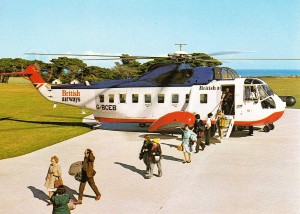
A BA S-61NM disembarking a typical passengers load after a Penzance/Scilly Isles Flight (Credit: via William Ashpole)
The CAA also note two other serviceable water impacts, both without fatalities and therefore irrelevant to this question:
- Bell 212 G-BARJ 24 December 1983 2 POB / 0 fatalities (AAIB report): Loss of control when winch cable snagged on ship during winch training. (IRRELEVANT)
- Sikorsky S-61N G-BDII 17 October 1988 4 POB / 0 fatalities (AAIB report): Loss of control during night-time hover during SAR operation (IRRELEVANT)
Summary
So rather than implied 38 fatalities in survivable water impacts, with 31 due to a failure to escape, from 1976-2012 in UK oil and gas operations there were 18 fatalities, with just 7 due to a failure to escape after surviving the impact. Those 7 fatalities were in accidents in 1990 and 1992. After a 21 year gap, the Sumburgh 2013 accident added 2 more fatalities, making 9 fatalities due to a failure to escape after surviving the impact (just 7% of all fatalities over 40 years [1976-2015]).
Does This Undermine The Case For Cat A EBS and Passenger Size Action?
Actually no! Both are sensible initiatives. The risk of a water impact or capsize after a ditching remains and variations in environmental factors such as water temperature, time of day (day or night) and sea conditions can adversely affect the outcome of any future ditching or survivable water impact. If an occupant is unable to survive the impact and egress the helicopter, their survival suit, life jacket, the aircraft life rafts, emergency locator transmitters and SAR support (for example) are all rendered worthless. On immersion in cold water, even as high as 25ºC, ‘cold shock‘ occurs. This causes an involuntary gasp and subsequent reduced breath hold times, potentially sufficient to compromise escape (we discussed the 4 phases of cold water immersion in an earlier article). Although the effort necessary to fully train the North Sea workforce in Cat A Compressed Air EBS shouldn’t be underestimated, Cat A CA-EBS is a relatively inexpensive counter to cold shock that can be introduced to any in-service helicopter. It also provides more time to escape (especially when the impact or capsize is sudden and without warning) and should reduce the risk of panic in the critical moments.
Aligning larger passengers with the larger escape windows is also a minimal cost piece of common sense. It also highlights that prescriptive regulations on window size based on typical passenger size only solve part of the problem and that focusing on outcomes (in this case successful egress and eventual safe recovery) is critical. It is interesting to reflect that in 1988 the UK CAA rejected an AAIB recommendation to physical test ditching, life raft deployment and evacuation after problems after the ditching of a Bell 214ST in the North Sea in 1986.
The Survival System
Fatalities in ditching and water impacts are also not just a North Sea issue, as demonstrated by this European Aviation Safety Agency (EASA) graphic looking at 2003 to 2012 (with the North Sea survival rate better than other regions):  This chart also shows that focusing on past accidents in one country is likely to be unrepresentative of the underlying risk. To better understand the survival / recovery measures in the vent of an offshore helicopter accident we recommend the Flight Safety Foundation (FSF) Basic Aviation Risk Standard for Offshore Helicopter Operations (BARSOHO), launched in May 2015. It is based on their of their award winning Basic Aviation Risk Standard, used in the mining industry, but specifically tailored to offshore helicopter operations. The whole BARSOHO standard is freely available with an accompanying implementation guide. The standard is orientated around a risk bow-tie, contains a number of common and specific threat controls as well as recovery measures for survival after an offshore accident (grouped in distinct categories, inspired by CAA CAP641: Review of Helicopter Offshore Safety & Survival published in 1995 after the Cormorant Alpha accident):
This chart also shows that focusing on past accidents in one country is likely to be unrepresentative of the underlying risk. To better understand the survival / recovery measures in the vent of an offshore helicopter accident we recommend the Flight Safety Foundation (FSF) Basic Aviation Risk Standard for Offshore Helicopter Operations (BARSOHO), launched in May 2015. It is based on their of their award winning Basic Aviation Risk Standard, used in the mining industry, but specifically tailored to offshore helicopter operations. The whole BARSOHO standard is freely available with an accompanying implementation guide. The standard is orientated around a risk bow-tie, contains a number of common and specific threat controls as well as recovery measures for survival after an offshore accident (grouped in distinct categories, inspired by CAA CAP641: Review of Helicopter Offshore Safety & Survival published in 1995 after the Cormorant Alpha accident): 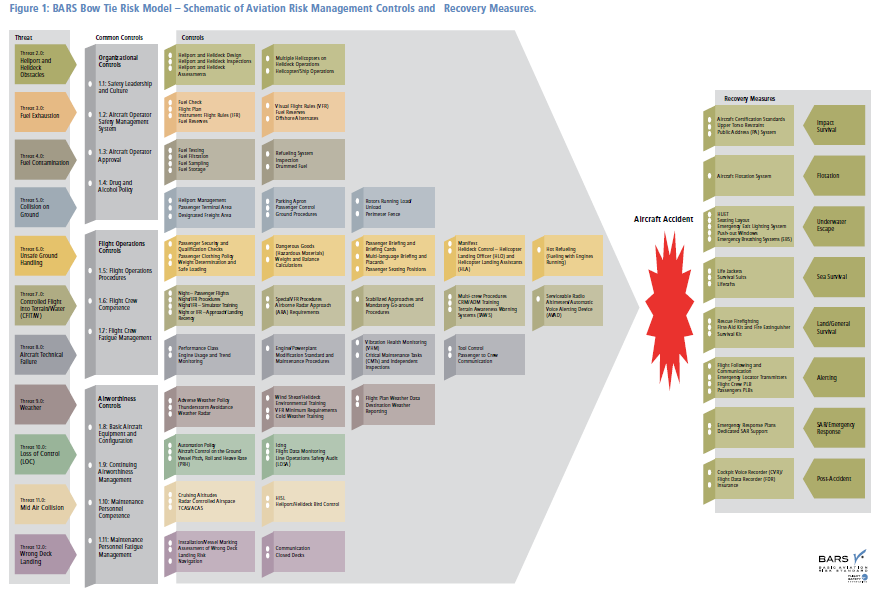 UPDATE 1 February 2017: BARSOHO Version 3, fully aligned with the HeliOffshore Safety Performance Model, is issued and available. The sub-divisions of survival / recovery measures highlight the need to think systemically about achieving the desire outcome (occupant survival). Each step needs to be completed successfully to achieve that desired outcome, so it is vital to maximise the chance of success for each step. However, just as significantly it is a reminder that survival measures are only a response to other causes of accidents, many of which are non-survivable. This emphasises the importance of attention on mechanical defects, loss of control events, collision with helideck obstacles and the causes of controlled flight into terrain events (among others). HeliOffshore is currently organising some ground breaking collaborative research into pilot monitoring using eye-tracking system and has produced expert guidance on the use of HUMS. The Royal Aeronautical Society (RAeS) held the conference Technology Friend or Foe – Automation in Offshore Helicopter Operations in 2014 and Aerossurance are sponsoring the follow-up in July 2016.
UPDATE 1 February 2017: BARSOHO Version 3, fully aligned with the HeliOffshore Safety Performance Model, is issued and available. The sub-divisions of survival / recovery measures highlight the need to think systemically about achieving the desire outcome (occupant survival). Each step needs to be completed successfully to achieve that desired outcome, so it is vital to maximise the chance of success for each step. However, just as significantly it is a reminder that survival measures are only a response to other causes of accidents, many of which are non-survivable. This emphasises the importance of attention on mechanical defects, loss of control events, collision with helideck obstacles and the causes of controlled flight into terrain events (among others). HeliOffshore is currently organising some ground breaking collaborative research into pilot monitoring using eye-tracking system and has produced expert guidance on the use of HUMS. The Royal Aeronautical Society (RAeS) held the conference Technology Friend or Foe – Automation in Offshore Helicopter Operations in 2014 and Aerossurance are sponsoring the follow-up in July 2016.
Extra Resources
If you found this article of interest you may also find these useful:
- The Hon Robert Wells QC’s Offshore Helicopter Safety Inquiry (OSHSI) following an S-92A accident offshore Canada in 2009, in which 17 people died and one passenger, Robert Decker, survived.
- The Dangers of Cold Water Immersion
- Helicopter Ditching – EASA Rule Making Team RMT.0120 Update on a new rule making initiative in Europe that will shortly proceed to a Notice of Propose Rulemaking
- New Helicopter Survival Suits in Canada for oil and gas flights off the Atlantic coast of Canada
- Norwegian Survival Suits: Suited for Safety
- Rapid Progress with a Category A EBS in the UK following CAP1145
- OPITO Compressed Air Emergency Breathing System (CA-EBS) Initial Deployment Training Standard
- UK BOSIET/FOET Cat-A EBS HUET Update
- So You Think The GOM is Non-Hostile? on a fatal US helicopter cold water survival accident in the Gulf of Mexico
- Canadian Coast Guard Helicopter Accident: CFIT, Survivability and More
- Scottish Court Orders Release of Sumburgh Helicopter CVFDR
- UK CAA CAP1145: Update on North Sea Helicopter Safety (CAP1243): Discussion of CAP1145, the one year progress review (CAP1243), the House of Commons Transport Committee report, the 1984 CAP491: Helicopter Airworthiness Review Panel Report, the 1995 CAP641: Review of Helicopter Offshore Safety & Survival and the 2010 SINTEF Helicopter Safety Study 3.
UPDATE 15 March 2016: AAIB Report on 2013 Sumburgh G-WNSB AS332L2 Helicopter Accident
UPDATE 23 March 2016: EASA published NPA 2016-01 Helicopter ditching and water impact occupant survivability on a 3 month public consultation period.
Previous studies on and accident investigations into helicopter ditchings and water impact events have highlighted inadequacies in the existing certification specifications (CS-27, CS-29) and in the rules governing offshore operations. In particular, it has been established that in an otherwise survivable water impact, most fatalities occurred as a result of drowning because the occupants were unable either to rapidly escape from a capsized and flooded cabin, or to survive in the sea for sufficient time until rescue. Furthermore, the testing environment in which helicopters are type-certified for ditching bears little resemblance to the sea conditions experienced in operation. In order to thoroughly address these and other ditching-related issues, and due to the nature of ditching-related hazards, this rulemaking task (RMT.0120 (27&29.008)) has taken a holistic approach to the problem, which crosses traditional airworthiness/operational boundaries. A detailed risk assessment has been undertaken that reflects both certification and operational experience and builds upon data extracted from accident reports and previous studies. The specific objective of this NPA, however, is to propose changes to CS-27 and CS-29… Retroactive rules are to be considered in a second phase of this RMT. …the primary change proposed aims to establish a new ditching certification methodology by which a target probability of capsize following a ditching can be determined based on the level of capsize mitigation applied to the design.
UPDATE 20 September 2016: The UK CAA today briefed the Oil and Gas UK Aviation Seminar that 300 comments were received, which were assessed at a three day EASA review session in July 2016.
UPDATE 24 September 2016: The UKCAA has issued CAP1386, their second update on CAP1145. We have summarised that report. The CAA comment on the recent EASA Notice of Proposed Amendment NPA 2016-01o on enhance survivability matters for future rotorcraft. The UK CAA also accept practical differences with implementing the ‘side-floating’ helicopter concept. the UK CAA does encourage further voluntary retrospective improvements. A number of these measures are included in the Flight Safety Foundation’s (FSF) Basic Aviation Risk Standard for Offshore Helicopter Operations (BARSOHO), launched in May 2015, orientated around a risk bow-tie, containing a number of common and specific threat controls. No doubt the UK CAA will examine with interest the long awaited International Association of Oil & Gas Producers (IOGP) revision of their Aviation Management Guidelines (currently Publication 390) to see what changes are made to enhance survivability.
UPDATE 1 February 2017: An update of BARSOHO (Version 3), fully aligned with the HeliOffshore SPM, is now available..  Aerossurance is pleased to be supporting both HeliOffshore and the Flight Safety Foundation in their work to improve offshore helicopter safety.
Aerossurance is pleased to be supporting both HeliOffshore and the Flight Safety Foundation in their work to improve offshore helicopter safety.
UPDATE 6 March 2017: HSS3b is issued (initially in Norwegian, with an English Exec Summary). It features comment on CAP 1145 and survivability matters. 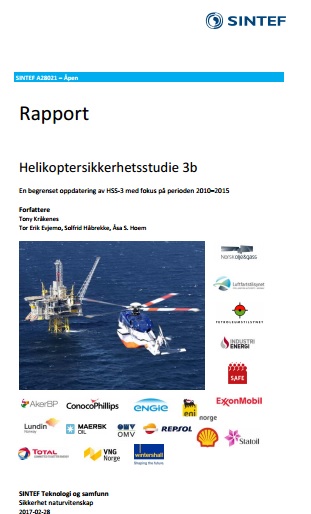
UPDATE 23 January 2020: Without fanfare UK CAA publish CAP 1877: Safety Review of Offshore Public Transport Helicopter Operations in Support of the Exploitation of Oil and Gas
UPDATE 12 December 2020: NH90 Caribbean Loss of Control – Inflight, Water Impact and Survivability Issues
UPDATE 9 January 2021: Korean Kamov Ka-32T Fire-Fighting Water Impact and Underwater Egress Fatal Accident
UPDATE 14 May 2022: Review of “The impact of human factors on pilots’ safety behavior in offshore aviation – Brazil”

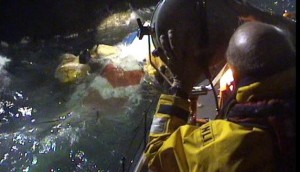
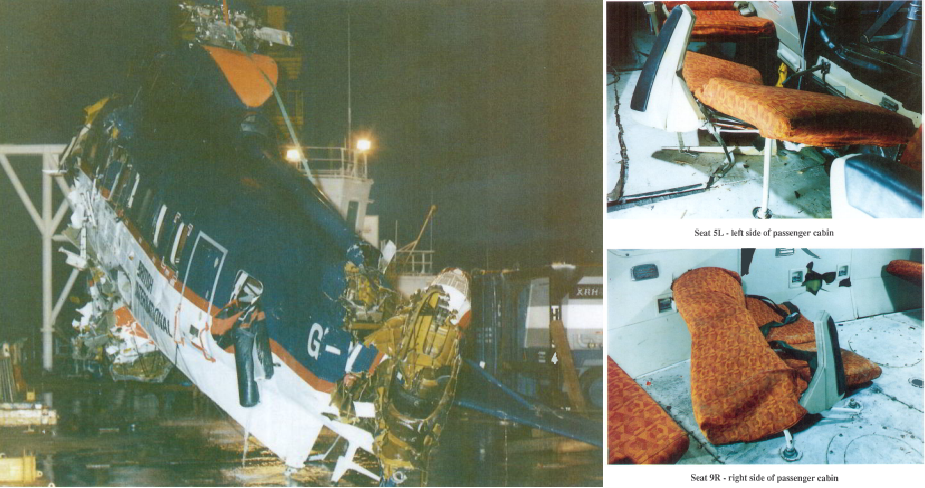
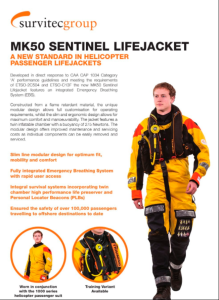
Recent Comments